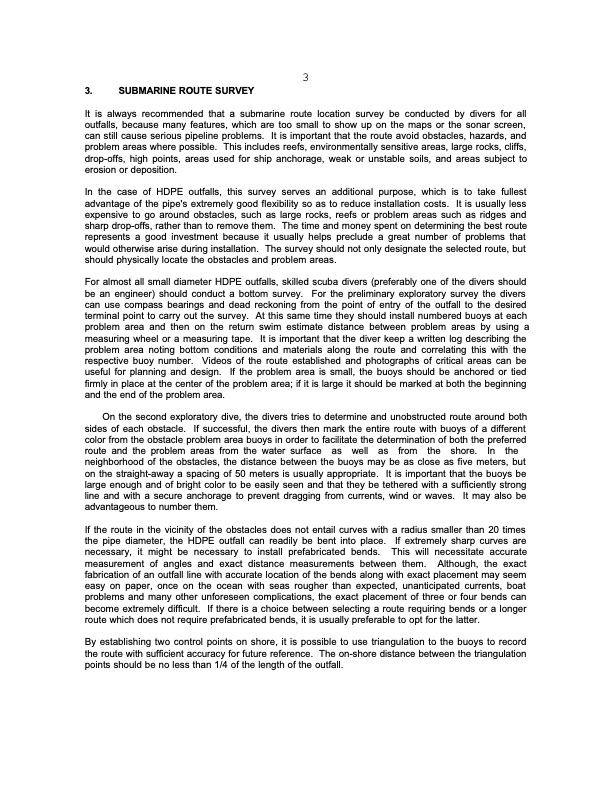
PDF Publication Title:
Text from PDF Page: 005
3. SUBMARINE ROUTE SURVEY 3 It is always recommended that a submarine route location survey be conducted by divers for all outfalls, because many features, which are too small to show up on the maps or the sonar screen, can still cause serious pipeline problems. It is important that the route avoid obstacles, hazards, and problem areas where possible. This includes reefs, environmentally sensitive areas, large rocks, cliffs, drop-offs, high points, areas used for ship anchorage, weak or unstable soils, and areas subject to erosion or deposition. In the case of HDPE outfalls, this survey serves an additional purpose, which is to take fullest advantage of the pipe's extremely good flexibility so as to reduce installation costs. It is usually less expensive to go around obstacles, such as large rocks, reefs or problem areas such as ridges and sharp drop-offs, rather than to remove them. The time and money spent on determining the best route represents a good investment because it usually helps preclude a great number of problems that would otherwise arise during installation. The survey should not only designate the selected route, but should physically locate the obstacles and problem areas. For almost all small diameter HDPE outfalls, skilled scuba divers (preferably one of the divers should be an engineer) should conduct a bottom survey. For the preliminary exploratory survey the divers can use compass bearings and dead reckoning from the point of entry of the outfall to the desired terminal point to carry out the survey. At this same time they should install numbered buoys at each problem area and then on the return swim estimate distance between problem areas by using a measuring wheel or a measuring tape. It is important that the diver keep a written log describing the problem area noting bottom conditions and materials along the route and correlating this with the respective buoy number. Videos of the route established and photographs of critical areas can be useful for planning and design. If the problem area is small, the buoys should be anchored or tied firmly in place at the center of the problem area; if it is large it should be marked at both the beginning and the end of the problem area. On the second exploratory dive, the divers tries to determine and unobstructed route around both sides of each obstacle. If successful, the divers then mark the entire route with buoys of a different color from the obstacle problem area buoys in order to facilitate the determination of both the preferred route and the problem areas from the water surface as well as from the shore. In the neighborhood of the obstacles, the distance between the buoys may be as close as five meters, but on the straight-away a spacing of 50 meters is usually appropriate. It is important that the buoys be large enough and of bright color to be easily seen and that they be tethered with a sufficiently strong line and with a secure anchorage to prevent dragging from currents, wind or waves. It may also be advantageous to number them. If the route in the vicinity of the obstacles does not entail curves with a radius smaller than 20 times the pipe diameter, the HDPE outfall can readily be bent into place. If extremely sharp curves are necessary, it might be necessary to install prefabricated bends. This will necessitate accurate measurement of angles and exact distance measurements between them. Although, the exact fabrication of an outfall line with accurate location of the bends along with exact placement may seem easy on paper, once on the ocean with seas rougher than expected, unanticipated currents, boat problems and many other unforeseen complications, the exact placement of three or four bends can become extremely difficult. If there is a choice between selecting a route requiring bends or a longer route which does not require prefabricated bends, it is usually preferable to opt for the latter. By establishing two control points on shore, it is possible to use triangulation to the buoys to record the route with sufficient accuracy for future reference. The on-shore distance between the triangulation points should be no less than 1/4 of the length of the outfall.PDF Image | SMALL DIAMETER (HDPE) SUBMARINE OUTFALLS

PDF Search Title:
SMALL DIAMETER (HDPE) SUBMARINE OUTFALLSOriginal File Name Searched:
OPSCEPISPUB0060_eng.PDFDIY PDF Search: Google It | Yahoo | Bing
Development of a solar powered Electric Ship The Electricship website originally started off as a project to develop a comprehensive renewable, affordable, modular electric ship... More Info
Modular Boat Hull Composite The case for a unsinkable, modular composite hybrid boat hull... More Info
MS Burgenstock Hybrid Electric Catamaran Lake Lucerne Unique shuttle servicing Lucerne to the Burgenstock Resort... More Info
Ground Power Unit GPU Powered by Lithium Ion Batteries The goal of the Ground Power Unit is to provide a readily accessible, modular, ready-to-power solution for remote power... More Info
| CONTACT TEL: 608-238-6001 Email: greg@electricship.com | RSS | AMP |